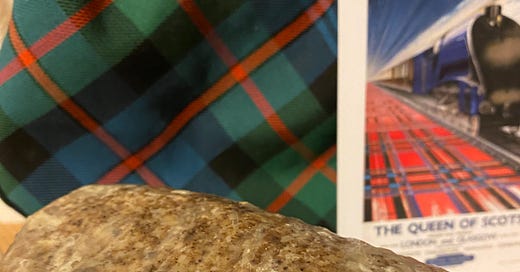St Andrew was a fisherman, the brother of Simon Peter whom he introduced to Jesus saying, ‘We have found the Messiah’. They were the first followers of Christ (John 1:35-42). Andrew was one of Jesus’ twelve apostles and is remembered as a fisher of men having met Jesus on the shores of the Sea of Galilee. He was present at the Last Supper, but was not considered one of Jesus’ inner circle of confidants.
F. Marian McNeill (A Calendar of Scottish National Festivals Hallowe’en to Yule) writes of Sancta Andra’s Day, Andyr’s Day or Anermas – the day of Scotland’s national saint. St Andrew was crucified by the Romans on a diagonal eponymous cross also known as the saltire. He believed his martyrdom unworthy of the cross of Christ. The saltire is the national flag of Scotland. Legend says that Saint Regulus (or Saint Rule) sailed from Greece to Scotland with the bones of St Andrew. After being shipwrecked the relics were housed in a specially built church - St Rule’. The tower of St Rules offers spectacular views over St Andrews, the sea and countryside beyond. It must have acted as a beacon for visiting pilgrims.
Scottish historian Walter Bower’s Scotichronicon (written in the 1440s) traces the history of Scotland and is an influential study of Medieval Scotland. In Vol 1 Book II he writes that Constantius, the son of Constantine the Great, motivated by enthusiasm for Christianity and stirred by the apostle St Andrew, went to Patras , Achaia (one of the seven provinces of Greece) where the apostle was buried to remove the saint’s relics by force. The bones were taken to Constantinople amid rejoicing. Bower continues with the role of the god-fearing abbot Regulus and his guardianship of the relics including the story of the shipwreck. Interestingly, Bower’s manuscripts were only translated into English from the original Latin relatively recently (1989 – 1998). Bower writes that the earthly remains of St Andrew performed miracles from the moment they reached Scottish soil. This attracted pilgrims which in turn supported the cult movement towards St Andrew as the patron saint of Scotland. In the preface Bower writes that he hoped that ‘all those who are depressed will be given joy by reading it’ – his History Book for Scots. The Scotichronicon presents the history of Scotland from its origin to the mid fifteenth century and is worthy of accolade albeit here, through the relics of St Andrew.
After graduating from the University of St Andrews I was employed by Scots Care (previously known as The Royal Scottish Corporation). The charity cares for London Scots who are in need of support be it financial or emotional wellbeing. In my working days there was a rather grand dinner on St Andrew’s day. Scotscare is the oldest Scottish charity outside of Scotland and was granted a Royal Charter in 1665. The charity began as a Scots Box that assisted impecunious Scots (assisting burial and poor relief) i.e. working in a grant making capacity and also offering a small pension to Scots living within a thirty five mile radius of Charing Cross. Today, it is an organisation that offers clients advocacy, psychotherapy, help with substance abuse, debt management, job-seeking assistance, sheltered housing, social events and volunteering opportunities and education and training. There is still a close association with the two London Scottish churches: Crown Court and St Columbas, Pont Street.
Since the Reformation, St Andrew’s Day has had little religious significance and Burns Day gathers greater Scottish feasting. However in times gone by to go Sant Andra-ing was a common pastime for farm workers who would trap rabbits and squirrels and end the day with much merriment.
Continuing on from Catterning (St Catherine’s Feast November 25th) St Andrew’s day shared St Catherine’s close association with the lacemaking districts of England - St Andrew is also a patron saint of Lacemakers. Possibly because the cross of St Andrew is thought to resemble intersecting threads. In common with Catterning, there were celebrations, called Tanders, on the Sunday closest to St Andrew’s day. This involved women dressing in male attire and vice versa, drinking and mumming. Mummers dressed in disguise and visited houses where refreshment was served; the mummer unmasked if their identity was discovered. This was relatively easy in small communities of local intimacy. Tandra cakes made from a dough of: flour, egg, lard, yeast, currants and crystalized lemon peel were eaten on St Andrews Day as was freshly hunted squirrel stew.
St Andrew’s Feast marks the end of the Church’s Liturgical Year and the beginning of Advent
St Andrew the King
Three weeks and three days
Before Christmas begins





Thank you, I loved the history of St Andrew.
My future daughter-in-law did her Master’s Degree at St Andrew’s. I remember last year she went to a Carol service with fellow graduates of the university here in London, I must ask her if she knows about the Charity you mention, I’m sure she’s be interested.
Wonderful post again.
I hadn’t realised that St Andrew, as well as being the patron saint of Scotland also provides protection against sore throats, convulsions, fever, and whooping cough! Clearly much needed for the winter season.
The traditions of the saint run deep in other countries too, such as Romania where basil picked on the Saint’s day is placed under a pillow to bring sweet dreams, but I suspect lemon peel will always be more popular!